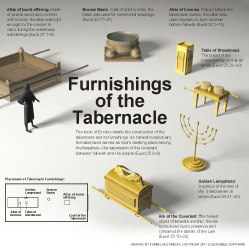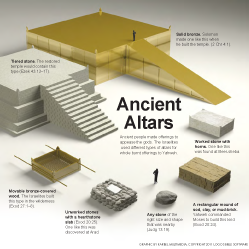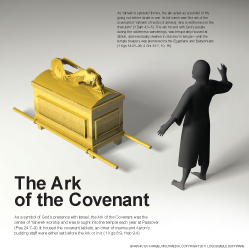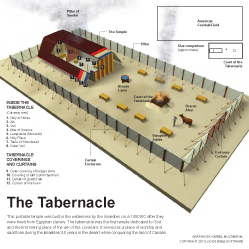30:1–10 In the first section of ch. 30, Yahweh gives Moses instructions for the altar of incense that will stand before the veil that covers the most holy place (holy of holies). This altar |
 Altars in the Old Testament Table
Altars in the Old Testament Table
30:2 a cubit The measurement from the tip of the fingers to the elbow—roughly 18 inches.
30:4 to carry it As with the ark of the covenant (25:10–22; 37:1–9) and the table (25:10, 23; 37:10–16), the altar of incense was designed to be carried without direct human contact.
30:6 the ark of the testimony The Hebrew phrase used here, aron ha’eduth, often rendered as “ark of the testimony,” is one of the common labels for the ark of the covenant (see 40:3; Num 7:89; Josh 4:16). See note on Exod 25:10.
atonement cover The lid of the ark. See note on 25:17.
30:7 fragrant incense The ingredients of the incense are listed in v. 34. The recipe uses tree resin, onycha, galbanum, and pure frankincense (nataph, shecheleth, chelbinah, and levonah in Hebrew, respectively). People in the ancient Near East burned incense so that the deity would smell the incense and be invited to its location. In the nt, incense symbolizes the prayers of believers (Rev 5:8; 8:3–4).
are listed in v. 34. The recipe uses tree resin, onycha, galbanum, and pure frankincense (nataph, shecheleth, chelbinah, and levonah in Hebrew, respectively). People in the ancient Near East burned incense so that the deity would smell the incense and be invited to its location. In the nt, incense symbolizes the prayers of believers (Rev 5:8; 8:3–4).
tends the lamps That is, the seven lamps on the lampstand (menorah) described in Exod 25:31–40; 37:17–24.
30:9 strange incense Refers to incense not prepared according to the instructions of vv. 34–38.
30:10 Aaron Meaning, whomever is the high priest. At this point in the biblical narrative, it is Aaron.
will make atonement Refers to purging of ritual impurity. See note on Lev 4:20.
a most holy thing Holiness refers to separation: someone or something is set apart for sacred, as opposed to ordinary, use.
refers to separation: someone or something is set apart for sacred, as opposed to ordinary, use.
30:11–16 This section prescribes a census of Israelite men (age 20 and older). In order to avoid a plague (Exod 30:12), each man must offer one half-shekel to God as a ransom for his life (vv. 12, 15–16). The money is designated for the service of the tent of meeting (v. 16). According to 38:25–26, this payment provided silver for the construction of the tabernacle. This is not an annual payment, but a one-time obligation. Since this collection precedes the tabernacle’s construction (see 38:24–28), this is a different census than the one commanded in Num 1, which comes after the tabernacle is constructed. |
30:12 the ransom of The Hebrew term used here, kopher, is related to the verb for making atonement (kaphar; see Exod 30:10 and note). This ransom is substituted for a physical consequence, as indicated in 21:30 (compare Num 35:31–32). In this context, the rationale is uncertain.
a plague The use of the Hebrew term negeph (“plague”) recalls the plague of the death of the firstborn (compare Exod 12:13).
30:13 shekel A unit for weighing metals as currency. One silver shekel weighed approximately 11–13 grams.
the sanctuary shekel In addition to their religious function, ancient temples and shrines served as the centerpiece of economic, political, and social activities, including the regulation of currency, storing taxes, and record keeping.
gerahs The Hebrew term used here, gerah, is likely cognate to the Mesopotamian giru (1/24 of a shekel in Mesopotamia’s monetary system). Ancient coins found in Israel and marked gerah weigh just over half a gram, on average.
is likely cognate to the Mesopotamian giru (1/24 of a shekel in Mesopotamia’s monetary system). Ancient coins found in Israel and marked gerah weigh just over half a gram, on average.
30:14 twenty years old The age where a man became eligible for military service (Num 1:3). The ransom payment might have some relationship to the risk of life in the upcoming wars to take the promised land.
30:15 poor will not give less Some offerings have varying requirements based on income (for example, the burnt offering in Lev 1). Here, there is no difference—each life is worth just as much to Yahweh, whether rich or poor.
30:16 a memorial Here, the purpose of giving a half-shekel is more clear—to remind the people that they owe Yahweh their lives. It is this remembrance that atones for the people, not the token offering itself.
30:17–21 The bronze basin (also called the laver) was not mentioned in the earlier instructions for tabernacle |
30:19 Aaron and his sons Meaning, the high priest and the priests.
will wash their hands and their feet This is the regular washing designed to keep the tabernacle clean. The washing associated with the consecration of the priests is prescribed in Exod 29 and takes place in Lev 8.
30:20 so that they do not die Here, washing is connected to purity, as any contamination could lead to a dangerous situation when working in the presence of God.
30:22–38 This passage describes the anointing oil and incense first mentioned in Exod 25:6. Spices, perfumes, and incense were generally reserved for use by temples and royalty in the ancient Near East. Their costliness was directly related to the expense of industry required to produce them from raw materials. |
 Tabernacle Materials and Equipment Table
Tabernacle Materials and Equipment Table
30:23 five hundred A unit of weight for weighing metals as currency. One silver shekel weighed approximately 2/5th ounce or 11–13 grams. The weight for other precious metals is unknown.
weighed approximately 2/5th ounce or 11–13 grams. The weight for other precious metals is unknown.
30:24 a hin of About four quarts (3.5 liters).
30:25 holy anointing oil This oil was used to show that an official, such as a priest or king, was chosen by God, by pouring the oil on top of the person’s head. The anointing oil was stored in the tabernacle and, later, the temple. Here, the oil is to be used on the tent of meeting, all of its furniture and utensils, and the priests.
30:27 table The table for the bread of the Presence, drink offerings, and incense in the holy place. See 25:23–30 and note.
lampstand The golden lampstand with seven lamps in the holy place. See note on 25:31.
the incense altar The small altar stationed in front of the veil leading to the most holy place, where the ark of the covenant was kept. See note on vv. 1–10.
30:28 the altar of burnt offering The main sacrificial altar in the courtyard of the tabernacle. See 27:1–8 and note.
30:29 you will consecrate The Hebrew word used here, qadash, means to set something or someone apart for sacred use. See note on 29:1 and note on 19:6.
30:30 you will anoint Aaron and his sons That is, the high priest and priests. More detailed directions about their anointing and consecration are given in ch. 29; these are carried out in Lev 8.
30:32 you will not make any like it The oil and spice mixture was to be unique. The uniqueness of the mixture would reinforce the firm distinction between the sacred and the common. Because of this restriction, a freshly anointed priest would even smell different than everyone else, signifying that he was set apart to God as holy.
30:33 will be cut off Likely means shunning or exclusion from the covenant community and its blessings. This punishment underscores the taboo of recreating this incense for pleasure. See note on Num 15:30.
30:34 stacte resin A fragrant tree resin; probably balsam or persimmon.
onycha The identification of this substance, called shecheleth in Hebrew, is uncertain. The Septuagint (the ancient Greek translation of the ot) translates shecheleth with the Greek word onych, meaning “talon,” “claw,” or “fingernail.” Ancient translations into Aramaic also used a word for claw or fingernail.
galbanum A plant resin that, when burned, increases the pungency of the ingredients with which it is mixed.
resin that, when burned, increases the pungency of the ingredients with which it is mixed.
frankincense The Hebrew word for “frankincense” used here, levonah, means “white.” It likely refers to the color of smoke produced when frankincense is burned.
30:35 pure, holy Purity and holiness are not the same thing. Purity is a state that enables something or someone to become holy or set apart. A state of ritual purity is necessary for someone or something to enter holy space.
30:36 the testimony See note on Num 4:5. Some of the spice mixture was to be burned on the altar of incense, which stood before the veil, behind which was the ark. Since the ark of the covenant was conceived of as the throne of God, with God sitting on top of it, the incense cloaked the divine presence as a preventative measure against unintentional death (Exod 19:11–25; 33:20).
30:37 holy to you for Yahweh This emphasizes that the people should not even consider making this type of incense for themselves, although they are certainly welcome to other forms of incense. The Israelites are to consider this particular recipe as taboo.

|
About Faithlife Study BibleFaithlife Study Bible (FSB) is your guide to the ancient world of the Old and New Testaments, with study notes and articles that draw from a wide range of academic research. FSB helps you learn how to think about interpretation methods and issues so that you can gain a deeper understanding of the text. |
| Copyright |
Copyright 2012 Logos Bible Software. |
| Support Info | fsb |
 Loading…
Loading…





